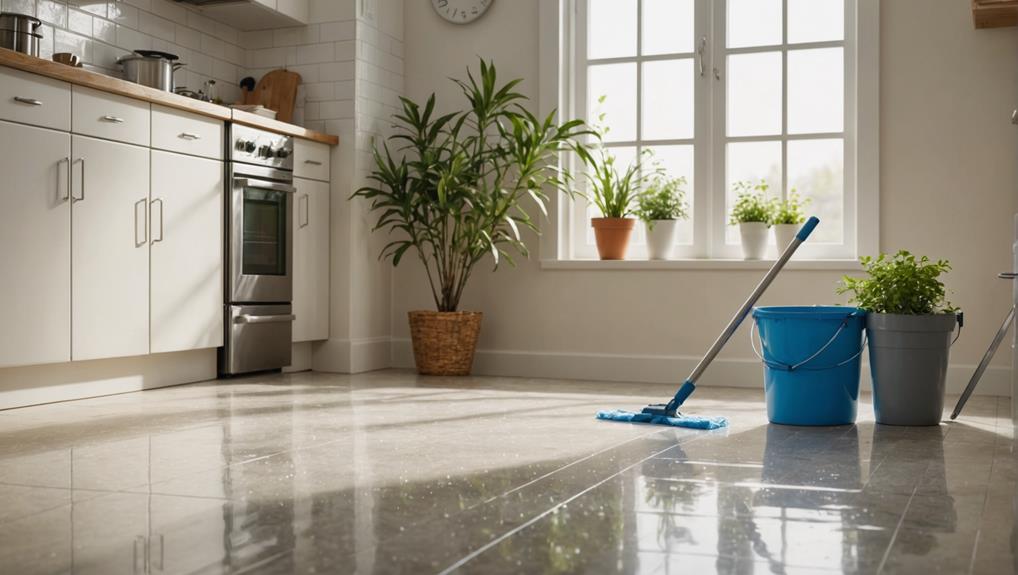To clean and maintain resilient vinyl flooring, start by regularly sweeping or vacuuming to eliminate dirt and debris. Use a damp microfiber mop with a pH-neutral cleaner for deeper cleaning, avoiding excess moisture. Address spills promptly to prevent mold. For periodic deep cleans, work in sections and rinse the mop often. If you encounter stains, apply the appropriate methods—like using rubbing alcohol for ink or dish soap for food. Invest in felt pads under furniture and keep the temperature stable to avoid material expansion. There's more to discover about proper care techniques to enhance your flooring's longevity and look.
Understanding Resilient Vinyl Flooring
When you're considering flooring options, it's essential to understand what resilient vinyl flooring is and how it can benefit your space. Resilient vinyl flooring is a synthetic material designed for durability and comfort. It's available in various types, including luxury vinyl tiles (LVT) and vinyl sheets, each offering unique characteristics that can suit different environments.
One of the key advantages of resilient vinyl flooring is its impressive vinyl durability. This durability makes it ideal for high-traffic areas, such as kitchens and entryways, where wear and tear are common. Unlike other flooring materials, resilient vinyl can withstand impacts, stains, and moisture, making it a safe choice for homes with pets or young children. Its water-resistant properties help prevent mold and mildew, contributing to a healthier living environment.
In addition to its resilience, the types of vinyl flooring available provide a wide range of aesthetic options. You can find designs that mimic natural materials like hardwood or stone, allowing you to achieve the desired look without sacrificing functionality. Moreover, many vinyl products come with a protective wear layer, enhancing both durability and ease of maintenance.
When selecting resilient vinyl flooring, consider the specific requirements of your space, including foot traffic levels and exposure to moisture. By understanding the benefits and types of vinyl flooring, you can make an informed decision that prioritizes both safety and style in your home.
Daily Cleaning Routine
To maintain the integrity of your vinyl flooring, it is crucial to establish a daily cleaning routine. Start by sweeping the surface regularly to remove dirt and debris, then use a damp mop for deeper cleaning without saturating the floor. Avoid harsh chemicals, as they can damage the finish and shorten the lifespan of your flooring.
Sweep Regularly
Regularly sweeping your vinyl flooring is essential for maintaining its appearance and longevity. Dust, dirt, and debris can accumulate quickly, leading to scratches and dullness if not addressed. For effective cleaning, choose the right cleaning tools, such as a soft-bristle broom or a vacuum with a hard floor setting. These options minimize the risk of scratching your flooring while ensuring thorough removal of particles.
When employing sweeping techniques, start from one corner of the room and work your way toward the exit. This approach prevents you from sweeping dirt back onto already cleaned areas. Use gentle, consistent strokes to capture debris without damaging the surface. If you encounter stubborn spots, consider using a dustpan and brush, ensuring you lift the debris rather than pushing it across the floor.
Remember to sweep at least once a day, especially in high-traffic areas, to maintain a clean and safe environment. Regular sweeping not only enhances the aesthetic appeal of your space but also prolongs the life of your resilient vinyl flooring, making it a vital part of your daily cleaning routine.
Use Damp Mop
After sweeping, incorporating a damp mop into your daily cleaning routine is key to keeping your vinyl flooring in top condition. Using a microfiber mop is highly recommended, as it effectively captures dust and dirt without scratching the surface. When you're ready to mop, dampen the mop with a suitable cleaning solution, guaranteeing it's not overly wet, which can damage the flooring.
Here's a quick reference table for your daily cleaning routine:
| Step | Detail |
|---|---|
| Mop Type | Microfiber mops are preferred for safety. |
| Cleaning Solution | Use a gentle, vinyl-safe cleaning solution. |
| Mopping Technique | Wring out the mop to avoid excess water. |
Make sure to work in small sections and change the mop pad as needed to maintain cleanliness. Regularly using a damp mop not only enhances the appearance of your flooring but also helps in reducing allergens. Remember to always follow manufacturer guidelines for any cleaning solutions to guarantee the longevity and safety of your resilient vinyl flooring.
Avoid Harsh Chemicals
While maintaining your vinyl flooring, it's crucial to avoid harsh chemicals that can cause damage over time. These substances, often found in conventional cleaning products, can strip away the protective finish of your flooring, leading to dullness and increased wear. Instead, consider using eco-friendly options that are both safe for your family and effective at cleaning.
Alternative cleaners, such as vinegar diluted in water or a mixture of baking soda and water, can work wonders without compromising the integrity of your flooring. These natural solutions are not only gentle on your vinyl but also safe for the environment. When cleaning, always test a small, inconspicuous area first to verify compatibility with your flooring.
Avoid products containing ammonia, bleach, or other abrasive agents. These can not only damage your vinyl but also pose health risks. Prioritize your safety by opting for labels that specify "non-toxic" or "biodegradable." By choosing eco-friendly options and alternative cleaners, you'll maintain the appearance and longevity of your vinyl flooring while creating a safe living space for you and your loved ones. Remember, a gentle approach to cleaning is key to preserving your investment.
Deep Cleaning Techniques
When it comes to deep cleaning your vinyl flooring, having the right cleaning supplies is essential for effective results. You'll want to follow a step-by-step process to guarantee every area is thoroughly cleaned, and knowing specific stain removal tips can help tackle tough spots. Let's explore these techniques to maintain the longevity and appearance of your vinyl floors.
Essential Cleaning Supplies
To effectively clean vinyl flooring, having the right essential cleaning supplies is crucial for achieving ideal results. Start with basic cleaning tools like a soft-bristle broom or vacuum cleaner designed for hard surfaces to remove dust and debris. Avoid using abrasive cleaning tools that can scratch the surface. A microfiber mop is excellent for applying a damp cleaning solution without excessive moisture, which can damage vinyl.
For deeper cleaning, consider a pH-neutral vinyl floor cleaner. This guarantees you're not introducing harsh chemicals that could harm your flooring. Additionally, keep floor protectors handy, such as felt pads for furniture legs, to prevent scratches and dents.
You might also want to invest in a spray bottle for easy application of your cleaning solution. Confirm your supplies are safe for both your flooring and your indoor air quality. Finally, always check product labels for compatibility with vinyl to avoid damaging your investment. With these essential cleaning supplies, you'll be well-equipped to maintain the beauty and longevity of your resilient vinyl flooring.
Step-by-Step Process
For a thorough deep cleaning of your vinyl flooring, follow a systematic step-by-step process that guarantees ideal results without damaging the surface. Start by gathering your essential cleaning tools, including a soft-bristle broom or vacuum cleaner, a mop, and a suitable vinyl floor cleaner.
Begin by sweeping or vacuuming the floor to remove loose dirt and debris. Next, prepare your cleaning solution according to the manufacturer's instructions. Dampen your mop with the solution, ensuring it's not soaking wet, as excess water can damage vinyl.
Mop the floor in sections, working from one corner to the exit to avoid stepping on freshly cleaned areas. Pay extra attention to high-traffic zones and corners, where dirt tends to accumulate. After mopping, rinse the mop frequently in clean water to avoid spreading grime.
Once the entire floor is cleaned, allow it to air dry completely. To maintain your vinyl flooring, establish a regular maintenance schedule, incorporating deep cleaning every 3-6 months. Following these steps will help preserve the beauty and longevity of your vinyl flooring while ensuring a safe and clean environment in your home.
Stain Removal Tips
Stains on vinyl flooring can be stubborn, but with the right techniques, you can effectively remove them without causing damage. Start by identifying the stain types—common culprits include ink, food, and grease. Each stain requires a specific approach to guarantee safe and effective removal.
For ink stains, use a cloth dampened with rubbing alcohol. Gently blot the area, avoiding excessive scrubbing that could harm the surface. For food stains, a mixture of warm water and mild dish soap works well. Apply the solution, let it sit for a few minutes, and then wipe clean with a damp cloth.
Grease stains can be effectively treated using a specialized cleaning solution designed for resilient vinyl flooring. Apply it according to the manufacturer's instructions, usually by spraying and wiping with a microfiber cloth.
Always test any cleaning solution on an inconspicuous area first to guarantee it doesn't discolor or damage your flooring. After removing the stain, rinse the area with clean water and dry thoroughly to prevent slip hazards. By following these stain removal tips, you can maintain the beauty of your vinyl flooring safely and effectively.
Stain Removal Methods
How can you effectively tackle stubborn stains on vinyl flooring? Whether it's a pet stain or ink that's marred your beautiful floors, addressing these issues promptly and safely is essential. Here are three effective methods for stain removal:
- Pet Stains: For pet stains, start by blotting the area with a clean cloth to absorb excess liquid. Then, mix a solution of warm water and a few drops of mild dish soap. Dampen a cloth with this mixture and gently scrub the stain. Rinse with clean water and dry with a towel.
- Ink Removal: Ink stains can be tricky, but they aren't impossible to tackle. Use rubbing alcohol on a cotton ball or soft cloth. Dab it on the ink stain without rubbing too hard, as this could damage the vinyl. Once the ink starts to lift, wipe the area with a damp cloth to remove any residue.
- General Stains: For general stains, a mixture of vinegar and baking soda can be effective. Sprinkle baking soda over the stain, then spray it lightly with vinegar. Let it fizz for a few minutes, then scrub gently with a soft brush. Rinse thoroughly afterward.
Always test any cleaning solution on a small, inconspicuous area first. By using these methods, you can maintain the integrity and appearance of your resilient vinyl flooring while ensuring a safe cleaning process.
Preventative Maintenance Tips
Regularly implementing preventative maintenance can considerably extend the life of your vinyl flooring and keep it looking its best. One of the most critical factors is temperature control. Vinyl flooring performs best within a temperature range of 65°F to 85°F. Extreme heat or cold can cause the material to expand or contract, leading to creasing or buckling. To maintain this range, consider using thermostats and ensuring your home is adequately insulated.
Moisture management is equally essential for preserving your flooring. Excessive moisture can lead to mold growth and deterioration of the vinyl. Always address spills immediately and utilize rugs or mats in areas prone to water exposure, such as entryways and kitchens. In high-humidity environments, using dehumidifiers can help maintain ideal moisture levels.
Regularly inspect your flooring for signs of wear or damage, and take action before issues escalate. Avoid dragging heavy furniture across the surface, as this can scratch and damage the vinyl. Instead, lift furniture when moving it, or use protective pads beneath furniture legs to distribute weight evenly.
Caring for High-Traffic Areas
High-traffic areas, such as hallways, entryways, and kitchens, require special attention to maintain the integrity and appearance of your vinyl flooring. These spaces are subject to constant wear and tear, making it vital to adopt effective care strategies. By being mindful of traffic patterns and furniture placement, you can protect your flooring investment and enhance safety.
Here are three key strategies for caring for high-traffic areas:
- Regular Cleaning: Sweep or vacuum daily to remove dirt and debris that can scratch the surface. Use a damp mop with a pH-neutral cleaner weekly to maintain a fresh appearance. Avoid harsh chemicals that can degrade the vinyl.
- Protective Mats: Place mats at entryways to catch dirt and moisture. Verify they have a non-slip backing to prevent accidents. This simple addition can greatly reduce damage from tracked-in grit and water.
- Strategic Furniture Placement: Arrange furniture to minimize direct foot traffic on specific areas. Consider using coasters or pads under heavy furniture to prevent indentations. Regularly rearranging furniture can also help distribute wear evenly over time.
Frequently Asked Questions
Can I Use a Steam Mop on Resilient Vinyl Flooring?
You might be wondering about using a steam mop on your resilient vinyl flooring. While steam mops can be effective for cleaning, they can also pose risks to vinyl floor care. Excessive heat and moisture can damage the adhesive or cause warping. It's best to avoid steam mops and opt for a damp mop with a suitable cleaner to guarantee your flooring remains intact and looking great for years to come.
How Often Should I Deep Clean My Vinyl Floor?
You should deep clean your vinyl floor at least once a month, but it can vary based on foot traffic. Did you know that regular deep cleaning can extend your flooring's lifespan by up to 30%? For daily maintenance, sweep or vacuum to remove debris, and use gentle cleaning products specifically designed for vinyl. Avoid harsh chemicals to guarantee safety and maintain the floor's integrity, preserving its appearance and longevity over time.
Is It Safe to Use Vinegar on Vinyl Flooring?
Using vinegar on vinyl flooring can be a safe option for cleaning, as long as it's diluted. Vinegar benefits include its natural ability to cut through grime and odors. However, you should avoid using undiluted vinegar, as it can damage the finish over time. Consider cleaning alternatives like pH-balanced floor cleaners for regular maintenance to guarantee your floors remain in top condition while preserving their longevity and appearance. Always rinse with water afterward.
What Should I Do if My Vinyl Floor Bubbles?
When your vinyl floor bubbles, it's like a blister on your skin—unpleasant and concerning. Bubbling can be caused by trapped moisture or improper installation. To address this, you'll need repair techniques like using a heat gun to soften the area and releasing trapped air. If moisture is the culprit, confirm the subfloor is dry. For safety, consider consulting a professional to prevent further damage and guarantee a proper fix.
Can I Install Vinyl Flooring Over Old Tiles?
Yes, you can install vinyl flooring over old tiles, but proper tile preparation is essential. Make certain the existing tiles are clean, level, and secure. If any tiles are loose or damaged, repair them before installation. Additionally, consider using an underlayment for added cushioning and moisture protection. When you're ready, follow the manufacturer's installation tips to guarantee a safe and durable finish. This approach will help prevent future complications and enhance your flooring's longevity.




